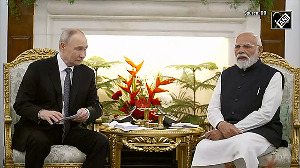The Chinese have only created limited defences for protection of their posts which are located much away from the Line of Actual Control, notes Colonel S Dinny (retd), who served as Commanding Officer of an infantry battalion deployed in the Pangong Tso area.

During the current border crisis between India and China in Eastern Ladakh, there has been an attempt made by some to project a narrative that China has captured Indian territory.
Genuine concerns of every Indian citizen on India's territorial integrity need to be addressed and questions need to be asked.
It is absolutely important that in a democratic country like India, the actions of the armed forces are debated, questioned and if need be criticised vehemently.
However, to quote unknown 'government or army sources' to create a fog of doubt, even while talks are on to resolve the issue, doesn't seem to be with the best of intentions.
The present India-China border crisis in Eastern Ladakh is not another Kargil.
There can be no 'capture' of Indian territory here.
And how can we say that? It is because, 'satellites don't lie' and the 'Indian Army has a time-tested reporting system'.
By now it is clear that troops of the People's Liberation Army and the Indian Army have locked horns in the areas along the Line of Actual Control on the North Bank of Pangong Tso, Galwan Valley and areas in the vicinity of Hot Springs.
The satellite images of these areas during this conflict, available as open source intelligence, brings out some interesting insights.
Along the Galwan Valley and in the areas of Hot Springs, image analysts indicated that both sides have taken close positions opposite each other, but within their own area of Line of Actual Control.
There has not been a single image showing any 'ingress' or 'capture' of Indian territory in these areas.
However, in the area between Finger 8 and Finger 4 on the North bank of the Pangong Tso lake, tents have been seen placed by the Chinese.
Indian deployment can also be seen in the area West of Finger 4.
It is very important to understand that these deployments from both sides are non-tactical in nature and more inclined towards an administrative deployment for accommodating troops temporarily.
There were also 'reports' that Chinese had 'captured the heights' along the Line of Actual Control.
This is also far from reality.
In Eastern Ladakh, the operational dynamics is not for 'capturing dominating heights' as attempted in the Line of Control scenario in Kashmir.
In Ladakh, the operations are purely to dominate the Line of Actual Control by patrolling and observation.
Here, the operations are not for an exchange of kinetic means, for which occupation of heights gives a distinct advantage.
Moreover, professionals in any army would know that to capture mountain heights is one of the most complex operations and requires a substantial quantum of troops.
But what is even more complex is to logistically sustain these troops at those heights.
There has been not a single image available which indicates, firstly Chinese troops occupying these heights and more importantly the 'unmistakable logistic supply chain', that is needed for these troops to survive in extremely treacherous terrain and climatic conditions.
It is also interesting to note that as a policy, the Chinese have not resorted to capture of heights for building up their defences anywhere along the Line of Actual Control.
They have only created limited defences for protection of their posts which are located well in depth and much away from the Line of Actual Control.
Another important aspect to understand is the Indian Army's reporting system.
As far as the troops on ground are considered there are no issues of perception or understanding of the Line of Actual Control.
They operate with maps having clear and unambiguous markings of the Line of Actual Control as handed over to them by the previous unit.
During handing taking over between units, the old and the new commanders both physically go on the ground and ratify the markings on the maps with positions on ground, before finally signing the handing taking over documents.
This then is also mandatorily ratified by commanders up the chain.
So, where is the question of hiding the truth?
A Chinese proverb says, 'The beginning of wisdom is calling things by the right names'.
So, let's not make the current crisis in Ladakh as another 'Kargil'.
Just like 'Depsang 2013', 'Chumar 2014' and 'Dokalam 2017', this is 'Pangong Tso 2020'.
Colonel S Dinny (retd) took voluntary retirement from the Indian Army on October 1, 2019 after serving as an infantry officer for about 22 years in which time he was the Commanding Officer of an infantry battalion deployed in the area of Pangong Tso, apart from multiple tenures in the Kashmir Valley, the north east and along the Line of Actual Control.
He has also served as a military observer with the United Nations in Congo.
Production: Aslam Hunani/Rediff.com










